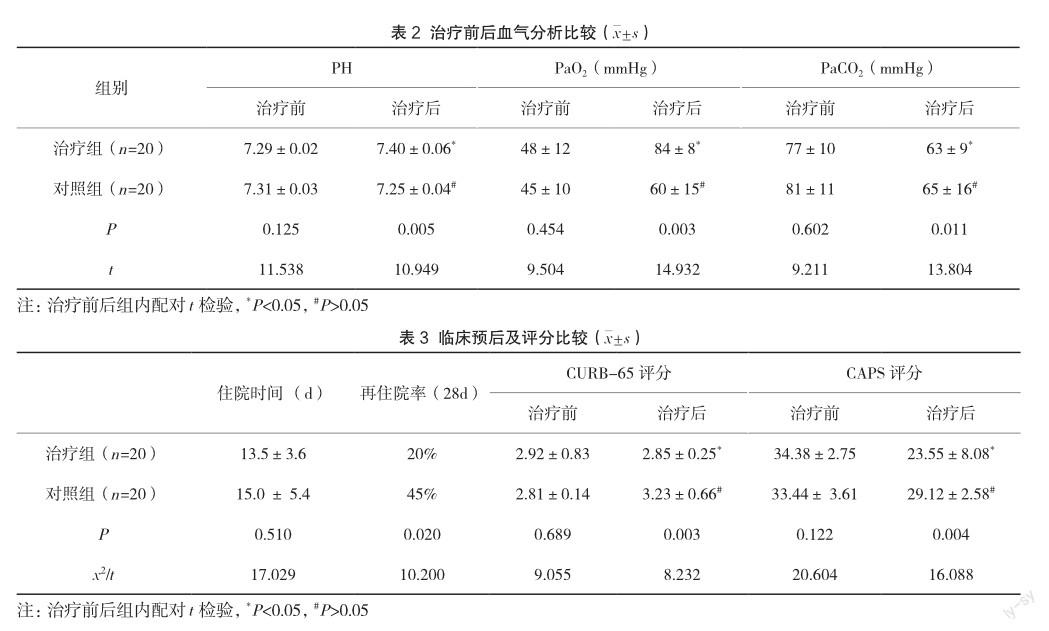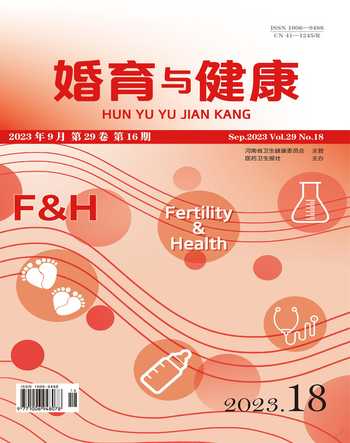經鼻高流量氧療對慢阻肺急性加重期患者的臨床療效觀察和評價
王軍

【摘要】目的:探討經鼻高流量氧療對慢性阻塞性肺疾病急性加重期患者的臨床療效及預后的影響。方法:選取慢阻肺患者40例,隨機分為治療組和觀察組,在常規藥物治療、護理等措施相同的基礎上,前者予以經鼻高流量氧療,后者予以傳統氧療,分別檢測入院時和經治療24h后的動脈血氣分析、平均動脈壓等指標,計算CURB-65和慢性阻塞性肺疾病和支氣管哮喘生理評分,記錄住院時間和28d再住院率,統計學分析比較相關指標。結果:兩組患者在性別、年齡和治療前的PH、PaO2、PaCO2比較差異無統計學意義(P>0.05),治療后,PH、PaO2兩組患者比較差異有統計學意義(P<0.05),治療組患者三項指標組內比較差異有統計學意義(P<0.05);兩組患者住院時間比較差異無統計學意義(P>0.05),28天再住院率比較差異有統計學意義(P<0.05)。BAP-65、CURB-65評分組內比較差異有統計學意義(P<0.05),組間比較差異無統計學意義(P>0.05)。結論:利用經鼻高流量氧療可明顯改善慢性阻塞性肺疾病急性加重期患者氧合狀態,減少患者體內二氧化碳的蓄積,緩解呼吸性酸中毒,適用于伴二氧化碳蓄積的慢性阻塞性肺疾病急性加重期患者,且療效和遠期預后優于傳統氧療。
【關鍵詞】慢性阻塞性肺疾病;急性加重期;經鼻高流量氧療;血氣分析
Clinical observation and evaluation of nasal high flow oxygen therapy in patients with acute exacerbation of chronic obstructive pulmonary disease
WANG Jun
Anqing Medical College of higher vocational school, Anqing, Anhui 246052, China
【Abstract】Objective:To investigate the effect of nasal high flow oxygen therapy on the clinical efficacy and prognosis of patients with acute exacerbation of chronic obstructive pulmonary disease (COPD). Methods: 40 patients with chronic obstructive pulmonary disease were randomly divided into treatment group and Observation Group. On the basis of routine drug treatment and nursing, the former was given high flow oxygen therapy through nose, the latter was given traditional oxygen therapy, arterial blood gas analysis and mean arterial pressure were measured at admission and 24 hours after treatment. Curb-65 and COPD and asthma physiological scores were calculated, the length of stay and 28-day readmission rate were recorded and analyzed statistically. Results: there was no significant difference between the two groups in terms of sex, age and PH、PaO2、PaCO2 before treatment(P>0.05). After treatment, there was significant difference in PH(P<0.05),PaCO2 between the two groups(P<0.05), there was no significant difference in the length of stay between the two groups(P>0.05), the 28-day readmission rate was significantly different(P<0.05). The scores of Bap-65 and CURB-65 were significantly different within groups(P<0.05), but not between groups(P>0.05). Conclusion: nasal high-flow oxygen therapy can improve oxygenation, reduce carbon dioxide accumulation and relieve respiratory acidosis in patients with acute exacerbation of chronic obstructive pulmonary disease, it is suitable for acute exacerbation of chronic obstructive pulmonary disease with carbon dioxide accumulation, and its curative effect and long-term prognosis are better than those of traditional oxygen therapy.
【Key Words】Chronic obstructive pulmonary disease; Acute exacerbation; Transnasal high flow oxygen therapy; Blood gas analysis
慢性阻塞性肺疾病進入急性加重期(Acute Exacerbation of Chronic Obstructive Pulmonary Disease,AECOPD)后,反復發作的咳嗽、喘悶、感染等表現嚴重影響了患者的生活質量并危及其生命安全。氧療通過增加吸入的氧氣濃度以提高吸入氣體的氧分壓,糾正低氧血癥進而改善此類患者的臨床癥狀,是目前常用的AECOPD治療方法,但傳統氧療方式提供的吸入氣體干燥、濃度偏低、患者耐受差,在糾正缺氧、高碳酸血癥的臨床效果不盡如人意[1]。目前,在急性低氧性呼吸衰竭、呼吸衰竭未行氣管插管、心功能不全等臨床病例中廣泛使用了經鼻高流量氧療(High Flow Nasal Cannula Oxygen therapy,HFNC)[2]。本研究旨在探討在常規治療、護理等措施的基礎上,利用HFNC技術對AECOPD患者進行治療,觀察其與傳統氧療的臨床療效及預后差異,具體報告如下。
1 資料與方法
1.1 一般資料
選取2021年9月—2022年10月學校附院呼吸內科收治的AECOPD患者40例,隨機分為治療組和對照組,各20例。對照組,男11例,女9例,年齡57~78歲,平均年齡(67.25±8.12歲);治療組,男6例,女14例,年齡57~78歲,平均年齡(62.56±10.62)歲;兩組病例在性別、年齡比較上差異無統計學意義(P>0.05)。納入標準:符合《慢性阻塞性肺疾病診治指南(2013年修訂版)》中相關標準,意識清醒,年齡在80歲以下,治療前PH>7.25,PaO2<60mmHg或伴PaCO2>50mmHg,患者及其家屬自愿參與本研究。排除標準:pH≤7.25,PaO2<40mmHg,PaCO2>65mmHg,需要進行重癥監護、機械通氣,合并有其他肺部疾病或嚴重心、肝、腎功能不全,近期有重大外傷或手術史,現在或曾經患有精神疾病或正在服用精神類藥物,對治療方法不耐受或中途退出者等。所有患者均簽署知情同意書。
1.2 治療方法
對照組接受傳統氧療,氧流量設為1~2L/min,治療組接受HFNC治療,氧濃度設為30%~50%,流量設為20~40L/min,溫度設為37℃。均持續治療24h以上。當PH≤7.25或PaO2<40mmHg或PaCO2>65mmHg,且2h無法糾正、意識障礙、呼吸困難、痰液增多排出困難、呼吸或心臟驟停的情況時停止氧療,終止研究,另行治療,本研究中未發現不良反應。兩組除氧療方式差異外,其他常規治療、護理等處理措施相同。
1.3 指標觀測及評分
入院后記錄每位患者的基本資料,治療前、24h后動脈血氣分析等指標,記錄患者住院時間、出院后28d內再住院率等。CURB-65(Confusion,Urea,Respiratory rate,Blood pressure,and Age,CURB-65)量表包括意識障礙、血尿素氮等5項指標。慢性阻塞性肺疾病和支氣管哮喘生理評分((the COPD and Asthma Physiology Score,CAPS)量表包括心率、平均動脈壓等8項指標,分別記分。所有數據雙人錄入。
1.4 數據統計
以MedCalc 20.218 統計學軟件進行本研究的數數資料采用(%)表示,進行x2檢驗,計量資料采用(x±s)表示,進行t檢驗,P<0.05為差異具有統計學意義。
2 結果

2.1 治療前后兩患者血氣分析的比較
治療前,PH、PaO2、PaCO2兩組患者比較差異無統計學意義(P>0.05),治療后,PH、PaO2兩組患者比較差異有統計學意義(P<0.05),PaCO2比較差異無統計學意義(P>0.05)。治療組患者三項指標組內比較差異有統計學意義(P<0.05),見表2。
2.2 兩組患者臨床預后及評分比較
兩組患者住院時間比較差異無統計學意義(P>0.05),28d再住院率比較差異有統計學意義(P<0.05)。BAP-65、CURB-65評分組內比較差異有統計學意義(P<0.05),組間比較差異無統計學意義(P>0.05),見表3。
3 討論
AECOPD 住院患者的氧療指征國內相關文獻中均有明確規定,一般應以改善患者的低氧血癥,保證動脈血氧飽和度(SaO2)在88%~92%為目標[3]。HFNC供給恒定濃度達21%~100%的氧氣,可為患者提供加熱加濕空氧混合氣體,避免氣道黏膜損傷[4-5],緩解炎癥反應[6-7],增加潮氣量,提高患者肺的換氣效率,與傳統氧療相比,舒適度更高[8]。因此,HFNC被逐漸應用于AECOPD的臨床實踐。但AECOPD患者使用HFNC的適應證目前尚不明確[9]。本研究比較了HFNC與傳統氧療對AECOPD患者的臨床療效,結果發現,治療組明顯改善了AECOPD患者血氧指標,且優于對照組,表明HFNC治療AECOPD能較好地緩解患者呼吸窘迫導致的缺氧狀態。治療24h后,對照組患者血氣分析指標與治療前比較差異無統計學意義,治療組患者的PaCO2明顯低于治療前和對照組,進一步說明,HFNC可以減少AECOPD患者體內二氧化碳的蓄積,改善呼吸性酸中毒。同時,治療組有效降低了患者28d再住院率,CURB-65、CAPS評分低于對照組,差異有統計學意義,HFNC遠期療效好于傳統氧療,這與國內外相關研究報道結論一致。
本研究結果顯示了使用 HFNC對改善AECOPD患者臨床癥狀和臨床結局方面的一些優勢,但研究樣本總量有限、觀察周期較短,未考慮患者基礎疾病及藥物因素的影響,因此,研究的初步結論需要進一步臨床研究驗證。
參考文獻
[1] Nishimura M.High-flow nasal cannula oxygen therapy in adults [J].Intensive Care,2015,3(1):15.
[2] Hern ndez G,Vaquero C,Gonzalez P,et al.Effect of Postextubation High-Flow Nasal Cannula vs Conventional Oxygen Therapy on Reintubation in Low-Risk Patients: A Randomized Clinical Trial[J].JAMA,2016,315(13):1354-1361.
[3] Lozano R,Naghavi M,Foreman K,et al.Global and regional mortality from 235 causes of death for 20 age groups in 1990 and 2010: a systematic analysis for the Global Burden of Disease Study 2010[J].The Lancet,2012,380(9859):2095-2128.
[4] Maggiore Salvatore Maurizio,Idone Francesco Antonio,Vaschetto Rosanna,et al.Nasal high-flow versus Venturi mask oxygen therapy after extubation[J].Effects on oxygenation,comfort,and clinical outcome.2014, 190(3):282.
[5] Pisani L,Vega M L.Use of Nasal High Flow in Stable COPD:Rationale and Physiology[J].Copdjournal of Chronic Obstructive Pulmonary Disease,2017(15):1-5.
[6] Price D R,Zappetti D.The Physiological Effect of High-flow Nasal Cannula[J].Clinical Pulmonary Medicine,2017,24(5):224.
[7] Lee M K,Choi J,Park B,et al.High flow nasal cannulae oxygen therapy in acute‐moderate hypercapnic respiratory failure[J].Clinical Respiratory Journal,2018,75(7):256-258.
[8] Jing G,Li J,Hao D,et al.Comparison of high flow nasal cannula with noninvasive ventilation in chronic obstructive pulmonary disease patients with hypercapnia in preventing postextubation respiratory failure:A pilot randomized controlled trial[J].Research in Nursing & Health,2019,15(4):88-91.
[9] 劉霜,朱華棟,于學忠,等.經鼻高流量氧療和無創正壓通氣對于肺源性中重度急性呼吸窘迫綜合征患者初始治療的效果評價[J].臨床急診雜志,2020,21(3):181-187.

